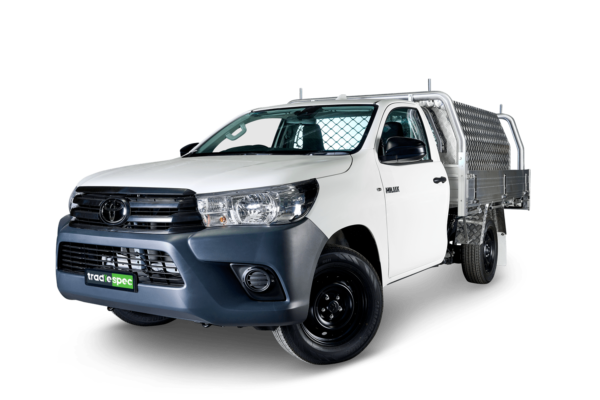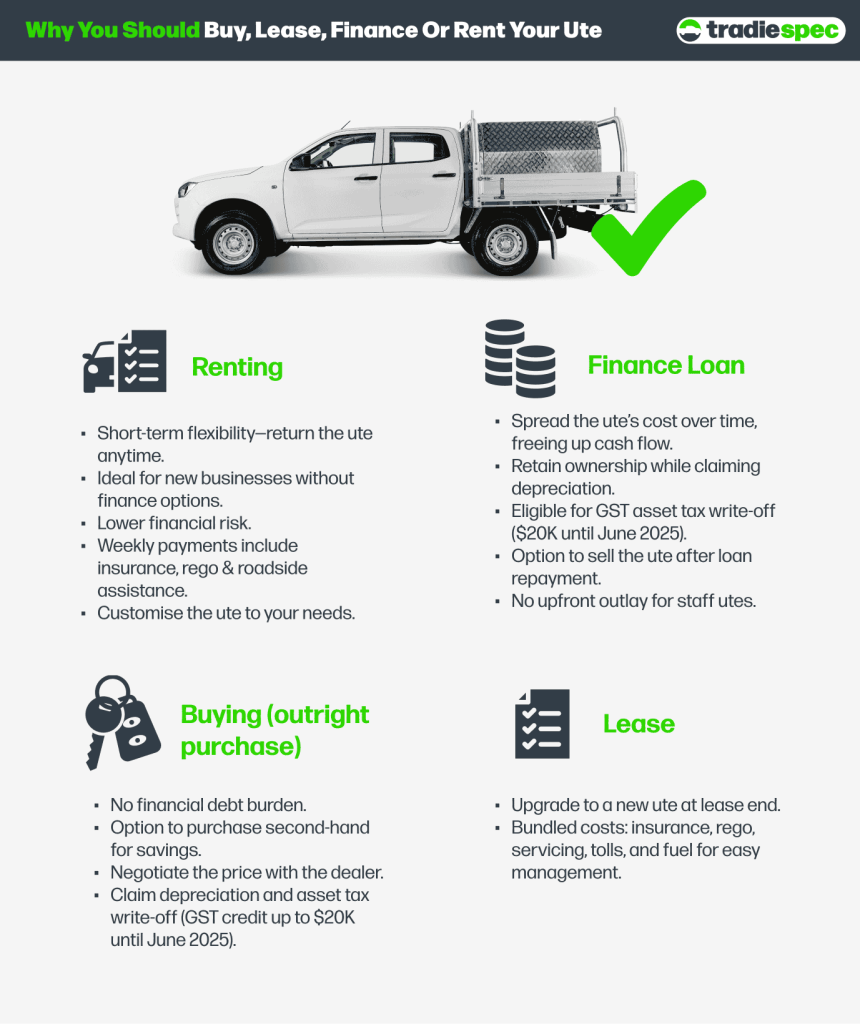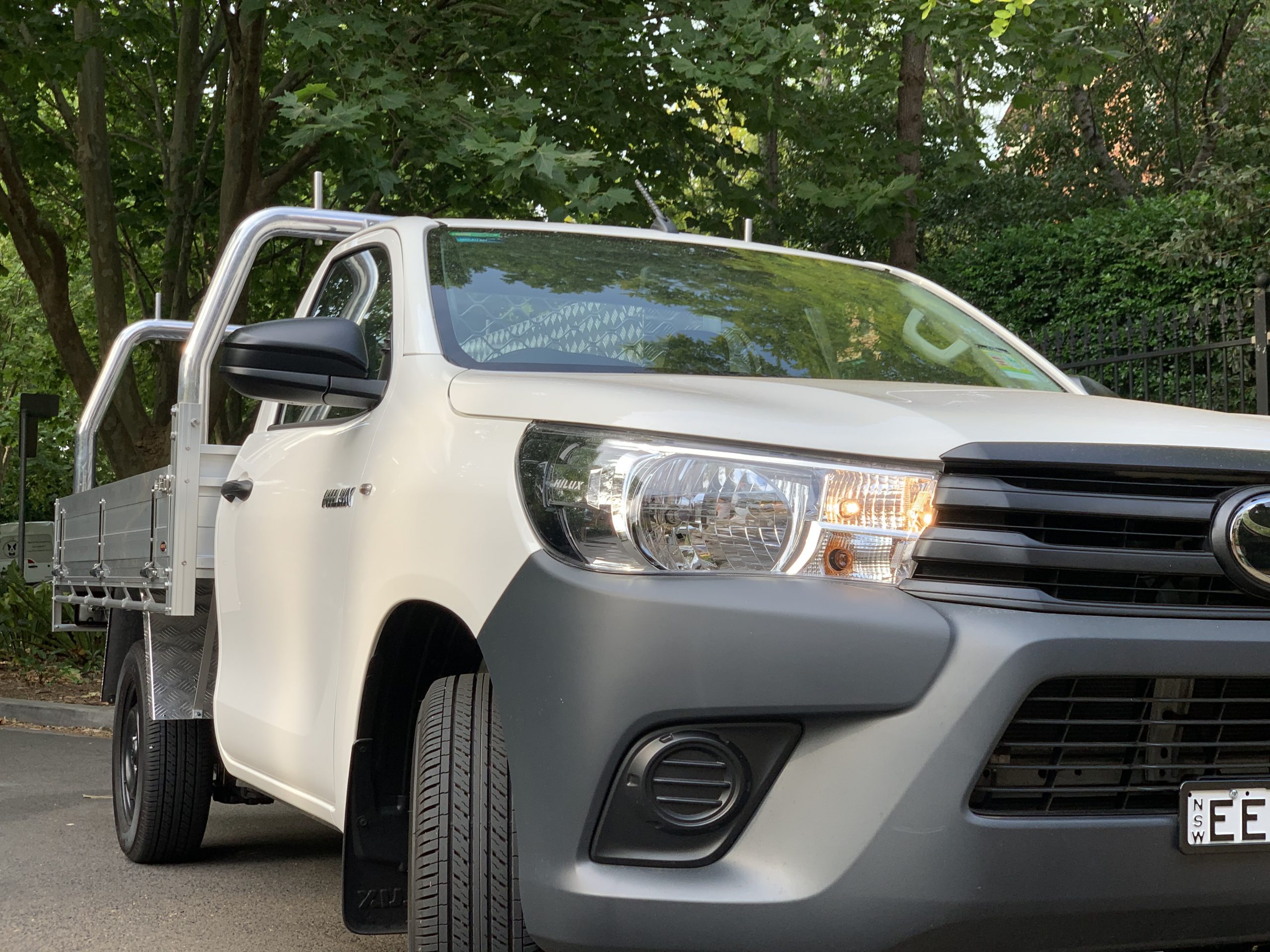There are so many variables to consider when you start looking for a new work ute, not just the make and model. Your work ute is often the largest purchase your business will make and it’s the most important purchase your business will make. Your work ute is your shop front. It’s the first thing your clients see as you or your employee pull into the driveway. So, a relatively new model of work ute that is kept clean and presentable will do wonders for your brand.
Naturally, the first consideration is your budget. Basic tray and tub-back Toyota HiLux’s range from $33,000 for a base model single cab tray back ute. All the way up to a top-of-the-range Toyota HiLux SR5 Rogue at $70,000.
Then comes the additional spec, toolboxes, tow bar, ladder racks, roof racks, squarker. You name it, you can spec it on your vehicle these days. However, all these come at additional costs.
But new utes are expensive, and a fleet of new utes is a huge expense on the business every month. It’s important to carefully consider your situation, and run the numbers on maintenance and servicing before you decide. We have broken down some of the factors you should consider for each option:
1. Buying (outright purchase)
Often considered the ‘safe’ option. But is it really? If you are running a trade business, then managing your cash flow is extremely important. Outlaying $30K to $70K on a brand-new work ute upfront can significantly dent your cash reserves.

So, let’s look at some of the advantages and disadvantages of buying:
A single cab 4×2 2.7L petrol Toyota Hilux tray back with Trade Spec’s
Advantages
- Avoid the financial debt burden.
- You have the option to purchase a secondhand work ute from a private seller.
- Negotiate the price on the ute with the dealer as hard as you want.
- Claim the yearly depreciation as a business expense.
- Claim the Asset instant tax write-off as a GST credit on assets up to $20,000 (until June 2025)
It’s important to consider the cashflow of your business and the financial position which your accountant can help with.
Disadvantages
- The ute will require care as to not depreciate the value faster than normal.
- A Toyota HiLux’s value will depreciate by 60% in 5 years at 30,000km travel per year. That’s $292 per month.
- Manage the yearly registration, insurance and maintenance costs yourself.
- Plans for new staff? Significant cash outlay for each new employee ute.
2. Finance Loan
Financing a ute also known as a Chattel Mortgage has held a bad reputation for some time. However, interest rates have fallen to below 5% in Australia in the last 20 years making finance a lot more affordable for everyone.
Financing a ute carries a range of advantages and disadvantages.
Advantages
- Amortise the cost of the ute. This basically means to write-down the initial cost of the ute over a period. Big tick for saving cashflow.
- You are still the registered owner over the ute so you can claim yearly depreciation as a business expense.
- Claim the asset instant tax write-off as a GST credit on assets up to $20,000 (until June 2025)
- The option to sell the ute for a profit after the loan is paid out, or during if warranted.
- No upfront cash outlay for new ute’s for staff
Amortisation is a business’s best friend when carefully planned and implemented.
Disadvantages
- The same depreciation liability as an outright purchase applies in this instance.
- Paying interest on the Loan means you will pay more than the initial value of the ute over the life of the loan.
- The burden of a finance requires careful planning in a business.
- Requires credit approval check which restrictions have tightened on.
3. Lease
Operating lease options are structured in a similar way to a loan in that you make monthly payments however you don’t own the ute. You may be restricted to the lease companies’ dealer network for ute selection however, the lease company may have the advantage of buying power when it comes to negotiating ute price. Again, the pro’s and con’s need to be weighed up separately.
Advantages
- Continue upgrading the ute when lease ends.
- Lease companies will usually give you the option of lumping the cost of insurance, servicing, registration, tolls and fuel into one easy to manage monthly payment.
- No initial cash outlay to obtain new model ute.
- You don’t carry the liability of a depreciating asset as you hand the ute back at the end of the lease.
Disadvantages
- It can cost just as much as a loan over the lease period.
- You don’t own the asset therefore don’t have the option of selling the ute for profit after.
- You may be restricted by the lease contract when making changes to the ute.
- You will be required to declare the operating lease on your balance sheet just like a loan.
- You will likely still require a credit approval check to obtain a lease.
- You are locked into making repayments for the life of the lease.
4. Renting
A new concept gaining momentum and interest with trade business owners. Traditionally, a rental ute was not part of the equation for business owners because of the cost of renting a ute. However, with new ute rentals available structured specifically for three to 12 month periods, it’s given Tradies another option to consider.
Many new business startups are restricted by the startup capital they have available to them and may not be able to apply for a lease on a ute. More established businesses may be bringing on new staff and don’t want the commitment of purchasing or leasing a ute over the long term until the new staff member has completed probation.
With Tradiespec, rental rates for utes start from anywhere from $349 per week if you go with our Rent-To-Own plan. This price includes all on-road costs as well as roadside assistance. However, with other short-term commercial rental companies you can be charged anywhere from $567 per week to $700 per week for a ute.
Advantages
- Shorter contract periods give you the flexibility of returning the ute when you are finished with it.
- Flexible option for a new business starter who can’t get finance on a new ute.
- Far less risk for the business for a new employee on probation for 3-6 months who require a ute.
- All the insurance, servicing and registration costs are covered in the weekly payment as well as roadside assistance.
- Spec the ute to your requirements.
Disadvantages
- Cost per day is slightly more expensive than lease or finance as you are paying for the flexibility.
- Can’t make changes to the ute unless approved by rental company.
Whatever you choose, the option needs to be the right fit for you and your business. It’s important to sit down and run the numbers for your business also to seek advice from your accountant.
It’s always worthwhile inquiring with different companies to find out what options they have available before deciding.


